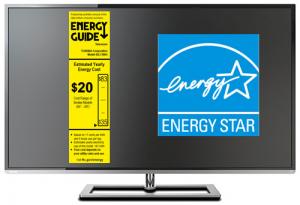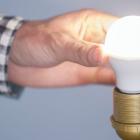Which TV to buy? An energy star certified TV
Submitted by Agata Gerroir on | Updated Tue, 06/12/2016 - 16:49

Buying a new TV is more complicated than it used to be. Which TV to buy? We all want to take advantage of better picture quality, we are all buying on a budget, and we are all trying to save on energy costs.
TV’s account for about 3% to 4% of home electrical usage in the average home says the Berkley Lab Report. To ensure you stay on the lower end of TV energy consumption, Energy Star rated Televisions are the way to go. “ENERGY STAR certified televisions are on average 25% more energy efficient than their conventional counterparts, “ says the EnergyStar.gov website.
Take an LCD/LED 50’ television. Its averages cost to operate and carbon foot print for the year are fairly low.
|
Dollar per Year |
$13.56 / year |
|
*KwH per Year |
107 KwH / year |
|
**CO2 per Year |
131lbs CO2 / year |
Note: These are averages. Your rates, and hours of usage will have an impact on the overall costs and carbon emissions.
http://ca.rtings.com/tv/learn/power-consumption-and-electricity-cost
*Energy.gov uses average rate of .1267KwH
**Carbonfund.org states we emit 1.222lbs CO2/KwH
Thirteen dollars a year, seems pretty reasonable to enjoy all our favorite shows, but the real savings are if you are upgrading an older technology. Later in the blog I also have a list of other things you can do to help further minimize your energy consumption costs if you already own an LCD energy star rated television skip to the ‘Taking it to the next level” section.
So why upgrade to the LCD/LED Energy Star television from your old Plasma, DPL or CRT television set?
All right TV’s, put up your dukes!
Round 1. Let the best man…erh, I mean TV win!
So how do the other technologies add up? Let’s take the average KwH usage from the US Home Report and see the difference between them.
|
|
LCD/LED |
CRT |
DPL |
Plasma |
|
*Dollar per Year |
$19 |
$18 |
$35 |
$41 |
|
KwH per Year |
150KwH |
145KwH |
275KwH |
325KwH |
|
*CO2 per Year |
183lbs |
177lbs |
336lbs |
397lbs |
*Energy.gov uses average rate of .1267KwH
**Carbonfund.org states we emit 1.222lbs CO2/KwH
Looking at the numbers we can clearly see that upgrading an old DPL and Plasma would save you around 50% or more on your bill each year all while lowering your overall carbon foot print.
CRT conversion doesn’t seem at first glance to be as drastic, but we have to consider the screen size for this one. LCD/LED televisions are sleeker and bigger then CRT televisions. So for the same or slightly less energy consumption, you get to watch a much bigger and better quality picture.
|
|
Savings in Energy, Cost and Carbon / year |
Screen Size |
Picture Quality |
|
CRT to LCD/LED |
Minimal |
Twice the screen size |
Increase in quality |
|
DPL to LCD/LED |
Approx. 50% decrease |
Same screen size |
Same quality or better |
|
Plasma to LCD/LED |
Over 50% decrease |
Same screen size |
Same quality |
Fraunhofer Report Figure 3-49 page 94
Other factors to consider for upgrading/purchasing an LCD/LED:
-
LCD/LED TV are most efficient. All of Energy Star’s Most Efficient 2016 Televisions are LCD/LED technology. This is an award for the elite of the Energy Star Rated televisions.
-
LCD/LED TV have the largest selection in size, and cost. Meeting most people’s budget and needs. Their prices range from as low as $200 to over $1000 depending on the extras you want, for example a smart TV, and the size of TV you want.
-
CRT, DPL and Plasma technologies are a fading breed. They are no longer sold in Canada and the US and can only be purchased on websites like eBay and Kijiji. They are less energy efficient technologies when compared to LCD/LED and are difficult to repair so not worth the investment.
-
LCD/LED technologies are the current market leaders. In the Fraunhofer Report LCD TV’s accounted for 63% of the market share in 2013.
Calculating your savings
If you like to know how much you are saving by upgrading your specific television set, go to the Energyusecalculator.com to calculate your average savings for the TV you currently use and the one you are looking to buy. (See Citations section for more calculators available online if you don’t like this one.)
Emerging technologies
There is an emerging technology that might soon be a contender for market share. OLED televisions. Note there are no true LED televisions available yet, although prototypes are being developed. The “LED” televisions in the market place are LCD televisions that use LED technologies. For a more in depth explanation of the different technologies scroll down to the bottom this article.
OLED’s are more efficient, but a newer technology so more expensive. They only come in larger sizes at the moment and so you wouldn’t see the energy savings on your bills coming through. Eventually they will be cheaper to manufacture then LCD/LED TV’s as they require less material, but we are not there yet.
So unless you have extra cash and love being the pioneer for new technologies, LCD/LED Energy Star rated TV’s are an easy way for you to be more eco-friendly.
This round goes too: LCD/LED Energy Star Rated Televisions.
Round 2. Which LCD/LED model to choose?
When deciding on an actual model of TV, I would suggest going to the EnergyStar.gov for a listing of all the TV models that have an Energy Star Rating. Look at the product specifications, it provides you the stand by power consumption and the on mode power consumption. Both are important when making a decision based on lower energy usage.
If you subscribe to Consumer Reports they also do a complete analysis of various TV models looking at quality, size, cost, and yes energy savings per year among other things to help you decide on your perfect TV set.
Remember, SIZE MATTERS when it comes to energy consumption. The bigger the TV the more power or energy it will use regardless of the technology. For instance, a 32” LCD/LED uses about half the energy of a 60” LCD/LED.
Round 3. The knock out
The winner by far though, is the off button.
The best way to save on energy consumption is to just turn off your TV.
Go for a walk, read that book you’ve been meaning to, or maybe even start a new hobby. You’d be surprised how much you get done when you devote the 5 hours of TV time daily to something else. And your wallet will say thank you with a few extra bills at the end of the year.
Which TV to buy: Taking it to the next level
Once you’ve bought your TV home, there are a few things you can do to further help save on energy consumption.
-
Make sure you are using the most efficient mode. If you bought a store model, it’s probably on the brightest possible mode, which is also an energy hog. The setting to look for is something like "Movie", "Pro", or "Normal". The setting usually to avoid are things like "Dynamic" or "Vivid. Samsung has even developed an Eco Saving Mode technology which adapts the picture to the intensity of the light in the room.
-
Make sure you have the Automatic Brightness Control (ABC) feature enabled if your TV has it. This feature adjusts screen brightness in real time, resulting in real energy savings says the NRDC.org report.
-
Buy TV attachments that are also energy efficient. Like your cable box, gaming systems, or surround sound use the same guidelines of an ENERGY STAR rating and wattage.
-
Use a smart power strip for your TV and TV attachments. If you can turn them off when not in use that will stop standby power loads from running up your electricity bill and wasting your money.
-
Don’t use your TV to deter burglars. If you feel the need to leave your TV on so burglars believe someone is home, why not buy yourself a fakeTV. It’s a little LED box that produces the same light as a TV but uses a lot less energy. Just in general, if you’re not using your TV; turn it off.
Last but not least, remember to recycle the old set!
Before you bring home your new Energy Star television, be sure you recycle your old TV appropriately.
Go to RecycleYourElectronics.ca to find the nearest drop off location near you. Check out their website for more tips for recycling.
If you have a smart TV one important thing to remember is that these devices store private information on them. Make sure you check with the manufacturer and ensure you’ve wiped your smart TV clean before recycling it.
To sum it up for being an eco Friendly TV viewer:
-
Buy LCD/ LED TV with an Energy Star Rating.
-
Buy a smaller TV. Smaller = Less Energy Usage.
-
Make sure your TV is set to the most efficient mode, and ABC has been enabled.
-
Use Energy efficient attachments.
-
Turn your TV off when you’re not using it! Or even set a goal to watch less!
-
Recycle the old set.
Understanding the difference between the TV technology types
|
Older, bulkier televisions. Those of us over 30 years of age probably remember growing up with one of these. Rumour has it that the newer TV’s are bigger energy hogs. That’s not true. Newer TV’s are two to three times bigger than the average CRT so in general the bigger you go, the more power you use. Dinosaur technology no longer being produced in America. Extremely inefficient. |
DLP (Digital Light Processing) (1,2)
|
This technology is also called ‘rear-projection’. It’s a regular enclosed TV, not as bulky as CRT but not as sleek as LCD and is available only in larger sizes. (50”+) These TV’s have a bulb that has to be replaced every few years, and in general require more maintenance. Dinosaur technology no longer being produced in America. Extremely inefficient. |
|
This technology uses pixels on the screen illuminated by a tiny bit of plasma (which is charged gas). Plasma TV’s are huge energy hogs when in use, especially compared to the other TV’s. Compare an LCD 52” averaging 280Watts to a 52” Plasma averaging 340 Watts. Endangered technology as the big TV companies like Samsung have pulled away from this technology. |
LCD (Liquid Crystal Display) (1,2)
|
LCD is the current market leader for TV technologies. Some manufacturers call LCD TV’s "LED TV's", but they're really LCD's TV's with LED backlighting. These LCD TV with LED technology tend to have better picture quality than the standard LCD models. Current market leader in TV technologies for price and efficiency. |
Note: True LED TV’s are just in the prototype stage, and may be a contender for being market leader in the future. Look up Sony's Crystal LED prototype if you are interested to learn more.
OLED (organic light-emitting diode) (1,2)
|
OLED works by putting electricity through materials that include carbon (‘organic’) matter to create a light when given electricity. OLED TV is a different technology than LED TV. OLED displays don't require backlighting, which means that they use much less power than most display technologies and can be extremely thin. They are also a new emerging technology and so are still very expensive to purchase. Potentially the future market leader. |
Citations:
http://www.consumerreports.org/products/lcd-led-oled-tvs/ratings-overview/http://www.diffen.com/difference/LED_TV_vs_OLED_TV
(1,2) The definitions in these charts were obtained from following websites.
http://michaelbluejay.com/electricity/tv.html
http://whatis.techtarget.com/definition/Flat-panel-TV-Guide
https://eetd.lbl.gov/sites/all/files/lbnl-5024e.pdf
http://www.nrcan.gc.ca/energy/products/categories/electronics/tv/14409
https://www.energystar.gov/products/electronics/televisions
http://www.displaymate.com/LG_OLED_TV_ShootOut_1.htm
https://www.nrdc.org/sites/default/files/uhd-tv-energy-use-ES.pdf
http://recycleyourelectronics.ca/drop-off-locations/
Energy efficient list of televisions from Energy Star:
https://www.energystar.gov/most-efficient/me-certified-televisions
Consumer Reports:
http://www.consumerreports.org/products/lcd-led-oled-tvs/ratings-overview/
Energy Efficient Calculators:
http://ca.rtings.com/tv/learn/power-consumption-and-electricity-cost
http://oee.nrcan.gc.ca/residential/business/energystar/procurement/calculator.cfm
http://michaelbluejay.com/electricity/tv.html
http://energyusecalculator.com/electricity_lcdleddisplay.htm
For more comparisons between the different types of TV sets, you can also look at some of the following websites:
http://www.ebay.com/gds/WHAT-TV-SHOULD-I-BUY-LCD-vs-PLASMA-vs-DLP-TVs-/10000000004154084/g.html
http://whatis.techtarget.com/definition/Flat-panel-TV-Guide
https://enervee.com/televisions/124275306_lg-50pz950u-50-3d-plasma-tv
Articles on life cycle of technologies:
(https://gcn.com/articles/2012/06/27/death-of-crt-monitors.aspx)
https://www.cnet.com/news/rip-rear-projection-tv/
http://www.consumerreports.org/cro/news/2014/07/plasma-tv-is-dead-so-go-buy-one/index.htm
http://www.consumerreports.org/products/lcd-led-oled-tvs/ratings-overview/http://www.diffen.com/difference/LED_TV_vs_OLED_TV
You will save the Earth by sharing and/or tweeting (corny right?)





